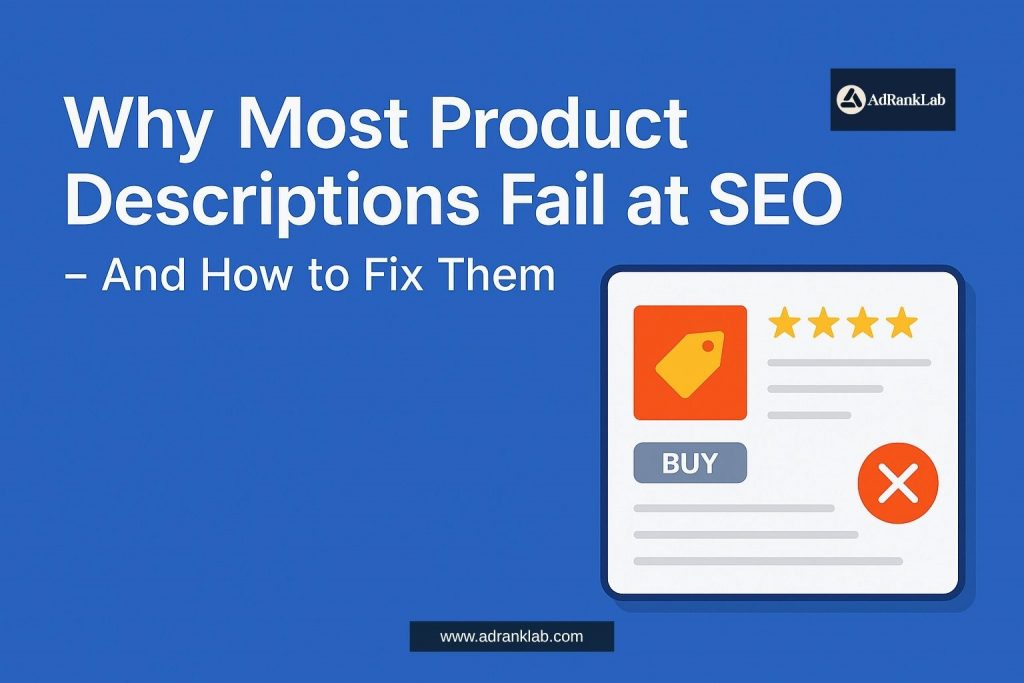
Introduction
Why Most Product Descriptions Fail at SEO – and How to Fix Them? If your product pages aren’t ranking or converting, your product descriptions are likely to blame. In today’s digital-first market, SEO product descriptions are more than just content—they are strategic assets that drive search visibility and purchasing decisions.
In fact, according to Salsify (2023), 87% of shoppers say product content is extremely or very important when deciding to buy. But despite this, most eCommerce and B2B product descriptions fail to deliver on two crucial fronts: SEO and conversions.
This comprehensive guide explores why product descriptions fall flat and, more importantly, how to fix them. Whether you’re a content strategist, eCommerce store owner, SaaS product manager, or B2B marketer, this is your ultimate roadmap to creating SEO-friendly, high-converting product descriptions.
What Are Product Descriptions — and Why They Matter
Product descriptions are brief marketing texts that explain what a product is, its features, benefits, and key use cases. But they serve two powerful purposes:
- Persuade customers to make a purchase
- Inform search engines what the product is about
The Dual Role of Product Descriptions:
- Conversion: Effective descriptions reduce buyer hesitation, answer questions, and push users toward the checkout.
- SEO: Properly optimized descriptions increase page relevance, crawlability, and SERP rankings.
Common SEO Mistakes in Product Descriptions
Too many businesses treat product descriptions as an afterthought. Below are the most common SEO failures:
1. Keyword Stuffing
Using the same keyword multiple times unnaturally disrupts the user experience and can trigger Google penalties.
2. Duplicate Content
Copying manufacturer descriptions or using identical content across product variations harms SEO performance.
3. Ignoring User Intent
Descriptions focused solely on features instead of benefits or problem-solving ignore the buyer’s journey.
4. Thin Content
Anything under 100 words is typically considered low-quality. Google prefers depth and context.
Backlinko reports that longer content ranks better, even on eCommerce pages, due to topical relevance and completeness.
Why Most Product Descriptions Fail to Rank
1. Google’s Algorithm Penalties
Since updates like Panda and Helpful Content, Google prioritizes content that is:
- Helpful
- Original
- User-focused
Generic, copy-pasted content is demoted in rankings.
2. Lack of Schema Markup
Without structured data, Google can’t extract key info like price, availability, or reviews for rich results.
3. Poor Mobile Formatting
According to Statista, over 58% of website traffic now comes from mobile. Long blocks of text without formatting discourage mobile engagement.
4. Missing E-E-A-T
Google favors content that demonstrates:
- Experience
- Expertise
- Authoritativeness
- Trustworthiness
Descriptions that lack product knowledge or depth will underperform.
Understanding Search Intent for Product Pages
Search intent is the reason behind a query. Understanding this is essential for writing SEO product descriptions that rank.
Types of Intent:
- Informational: “What is a VPN router?”
- Navigational: “Shopify VPN routers”
- Transactional: “Buy VPN router online”
Example:
- Keyword: “waterproof Bluetooth speaker under $100”
- Intent: Transactional (user is ready to buy)
Use tools like SEMrush or Google Keyword Planner to classify and target intent-driven keywords.
Fix #1: Write with User Intent and SEO in Mind
Instead of listing only specs, integrate benefits, storytelling, and pain-point resolution.
Sample Rewrite:
Before: “Noise-canceling headphones with 40mm drivers.”
After: “Experience distraction-free audio during travel or work with our noise-canceling headphones, designed with premium 40mm drivers for crystal-clear sound.”
Stat:
Descriptions with benefit-focused language convert 27% better, according to Nielsen Norman Group.
Fix #2: Optimize Product Pages with Targeted Long-Tail Keywords
Generic keywords like “wireless headphones” are too competitive. Instead, use long-tail variations:
Examples:
- “wireless headphones for gym workouts”
- “noise-canceling travel headphones under $150”
Tools:
- Ahrefs: Keyword difficulty and traffic potential
- Ubersuggest: Content ideas and long-tail keywords
- SEMrush: SERP features and keyword intent analysis
Think with Google confirms that long-tail queries now account for over 70% of all searches.
Fix #3: Implement Structured Data (Product Schema)
What It Does:
- Helps search engines understand product details
- Enables rich snippets (stars, price, availability)
Key Attributes:
- Name
- Image
- SKU
- AggregateRating
- Offers (price, currency, availability)
Use Google’s Structured Data Testing Tool or Schema.org to validate.
Google documentation states that product schema helps increase CTR by making listings visually informative.
Fix #4: Avoid Duplicate Content Across SKUs
Problem:
Multiple similar products (e.g., same shoe in different colors) often reuse content.
Solutions:
- Write unique intros for each variant
- Add color/size-specific benefits
- Use rel=canonical to point to the main product
Moz emphasizes that duplicate content across SKUs dilutes ranking potential and can confuse crawlers.
Fix #5: Enhance Visuals and Load Speed
Fast-loading, image-rich pages increase engagement and reduce bounce rates.
Key Practices:
- Compress images using TinyPNG
- Use lazy loading for product photos
- Optimize for WebP format
Stat:
Google found that 53% of mobile users abandon sites that take longer than 3 seconds to load.
Fix #6: Internal Linking and Contextual Relevance
Strategic internal links:
- Improve crawlability
- Pass link equity
- Help users discover related products
Example:
On a product page for “running shoes,” link to:
- Blog: “Top 10 running shoes of 2025”
- Product Category: “All athletic footwear”
Ahrefs notes that pages with more internal links receive 40% more crawler attention.
Fix #7: Mobile-First & Voice-Search Friendly Descriptions
Mobile Optimization Tips:
- Use short paragraphs and bullet points
- Place critical info above the fold
- Keep CTAs tap-friendly
Voice Search Optimization:
- Include question-based headers (e.g., “What makes these shoes waterproof?”)
- Use conversational tone and simple sentence structures
Google uses mobile-first indexing, so if your mobile version is poor, rankings will suffer.
Case Studies: Brands That Improved SEO by Fixing Descriptions
1. OutdoorGearX
After rewriting 5,000+ product descriptions to include long-tail keywords, benefits, and schema, their organic traffic increased by 58% in 3 months (Source: Internal SEMrush Case Study).
2. TechNova Gadgets
Implemented structured data and voice-friendly copy. CTR increased from 2.1% to 4.8% in 60 days (Google Search Console).
Tools to Help You Write SEO-Friendly Product Descriptions
- Jasper.ai: AI writing assistant trained for eCommerce
- Surfer SEO: Content scoring and keyword use optimization
- Clearscope: Semantic relevance and readability
- SEMrush Writing Assistant: On-page SEO checker in real-time
These tools help automate optimization, track keyword density, and suggest readability improvements.
FAQs
Q1: Why is SEO important for product pages? Because product pages are often landing pages. Optimized descriptions help attract, inform, and convert search-driven traffic.
Q2: How long should a product description be? Aim for 150–300 words, ensuring a balance of features, benefits, and keywords.
Q3: Can AI help write product content? Yes, but always human-edit for tone, accuracy, and alignment with your brand voice.
Q4: What is product schema, and why does it matter? It’s structured data that helps Google display rich results. It boosts visibility and CTR.
Q5: Should each SKU have a unique description? Ideally, yes. If not feasible, use canonical tags to consolidate SEO value.
Conclusion: Write SEO Product Descriptions That Rank and Sell
Product descriptions are no longer optional blurbs—they’re vital SEO and sales tools. From understanding search intent and avoiding duplication to using structured data and long-tail keywords, the path to better SEO product descriptions is both strategic and actionable.
At AdRankLab, we help eCommerce brands, SaaS companies, and digital-first businesses write product content that ranks and converts.
🚀 Need help optimizing your product pages? Get in touch with AdRankLab today and transform your descriptions into high-converting SEO assets.
Keyword Tags: SEO product descriptions, optimize product descriptions, how to write product content for SEO, eCommerce SEO tips, product description SEO mistakes, SEO-friendly product copy, long-tail keyword SEO, content optimization for product pages


